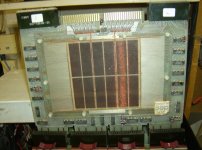Iv recently had some fun trying to get some more core stacks back to life, with some success but also some issues.
One stack had LOTS of steering diodes failed, now Iv "bodged" it using the good one 1N4148's but for reliability would like to change the actual DIL packages, DEC -2501-00, has anyone found a replacement for this or will I have to make something up ?.
I have also found 2 stacks with open sense/inhibit lines , anyone tried actual stack repairs ? , I still need to try and find the actual location of the OC, I intend to ground all the lines apart from the faulty one and then inject a 1k tone on it and see if I can do a non contact trace, then borrow a microscope and see what I can see.
, anyone tried actual stack repairs ? , I still need to try and find the actual location of the OC, I intend to ground all the lines apart from the faulty one and then inject a 1k tone on it and see if I can do a non contact trace, then borrow a microscope and see what I can see.
Pic of the bodged stack below, the vertical red band is a flash artifact !
DaveH
One stack had LOTS of steering diodes failed, now Iv "bodged" it using the good one 1N4148's but for reliability would like to change the actual DIL packages, DEC -2501-00, has anyone found a replacement for this or will I have to make something up ?.
I have also found 2 stacks with open sense/inhibit lines
Pic of the bodged stack below, the vertical red band is a flash artifact !
DaveH

